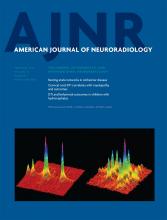Article Figures & Data
Tables
RRMS (n = 20/47) CIS (n = 27/47) RRMS Control MCIS Control PCISWOE Control PCISWE Control No. of subjects 20 20 9 9 9 9 9 9 Mean age at disease onset (yr) 14.23 NA 12.99 NA 15.06 NA 9.37 NA Range 6.6–16.5 4.1–17.4 13.9–18 2.6–15.3 Mean age at the time of MRI (yr) 15.92 15.925 13.58 13.58 15.58 15.52 9.74 9.4 Range 8.4–18 7.7–18 4.1–18 4–17.5 14.5–18 13–17 2.6–15.8 2–15 Female sex (%) 75% 77.78% 66.67% 55.56% Race White 75% 77.78% 66.67% 44.44% Hispanic 05% 00% 22.22% 11.11% American black 15% 11.11% 11.11% 22.22% Asian 05% 11.11% 00% 11.11% Mean disease duration from 1st Sx to MRI analyzed 2.11 yr NA 0.27 yr NA 0.37 yr NA 0.1125 yr NA Mean EDSS 1.625 NA 1.83 NA 1.38 NA 2.6 NA No. of patients on DMT at the time of MRI 15/20 NA 00/10 NA 02/09 NA 00/10 NA Avonexa 05/15 NA 00/10 NA 00/09 NA 00/10 NA Rebifa 04/15 NA 00/10 NA 01/09 NA 00/10 NA Copaxoneb 04/15 NA 00/10 NA 01/09 NA 00/10 NA Multiple drugs 02/15 NA 00/10 NA 00/09 NA 00/10 NA No. of patients on monthly steroids 05/20 NA 00/10 NA 00/09 NA 00/10 NA No. of patients on steroids within 1 month of MRI 05/20 NA 06/10 NA 02/09 NA 10/10 NA Conventional MRI Features MRI at the Time of Presentation MRI at the Time of Diagnosis MCIS PCISWOE PCISWE RRMS Lesion location Gray matter cortex 0 0 2 3 BG and thalamus 0 2 6 12 Subcortical 0 5 8 19 Periventricular 1 7 4 20 Perpendicular to CC 0 2 2 16 Internal capsule 0 1 2 7 Abutting the LV 0 0 0 10 Cerebellum 0 0 4 12 Brain stem 0 4 4 12 Spinal cord 2 3 0 13 Optic nerve 6 0 2 0 No. of T2 lesions in the brain (range) 0–1 5–46 1–22 2–136 No. of T2 lesions in the SC (range) 0–2 0–7 0–7 0–11 Lesion characteristics Well-defined lesions 4 1 16 Diffuse 1 8 10 22 Ovoid 0 7 4 20 Irregular-shaped 0 6 9 19 Confluent 0 1 1 6 Tumorlike 1 0 4 5 Gd enhancement 6 1 1 6 T1 black hole 0 0 0 11 Note:—BG indicates basal ganglia; LV, lateral ventricle; SC, spinal cord; Gd, gadolinium; CC, corpus callosum.
Patient Control P Value CC Tract mean ADC (SD)a 0.94 (0.13) 0.85 (0.089) .0025b Tract mean FA (SD) 0.52 (0.037) 0.57 (0.028) .0001b PLIC Tract mean ADC (SD)a 0.73 (0.058) 0.70 (0.059) .030b Tract mean FA (SD) 0.54 (0.035) 0.56 (0.032) .020b CP Tract mean ADC (SD)a 0.75 (0.058) 0.72 (0.060) .0025b Tract mean FA (SD) 0.56 (0.037) 0.59 (0.042) .037b LAF Tract mean ADC (SD)a 0.81 (0.083) 0.76 (0.064) .0054b Tract mean FA (SD) 0.44 (0.034) 0.47 (0.031) .017b Patients Controls P Value Genu of CC Mean ADC (± SD)a 0.87 (0.10) 0.82 (0.11) .052 Mean FA (± SD) 0.53 (0.050) 0.56 (0.051) .098 Splenium of CC Mean ADC (± SD)a 0.91 (0.13) 0.79 (0.095) .0010b Mean FA (± SD) 0.58 (0.073) 0.65 (0.052) .0003b AMB of CC Mean ADC (± SD)a 0.89 (0.12) 0.79 (0.085) .0005b Mean FA (± SD) 0.52 (0.057) 0.57 (0.051) .0053b PMB of CC Mean ADC (± SD) 0.93 (0.12) 0.84 (0.11) .011b Mean FA (± SD) 0.53 (0.051) 0.57 (0.051) .032b PLIC Mean ADC (± SD)a 0.72 (0.053) 0.71 (0.059) .38 Mean FA (± SD) 0.56 (0.039) 0.56 (0.031) .77 CP Mean ADC (± SD)a 0.74 (0.061) 0.73 (0.065) .29 Mean FA (± SD) 0.58 (0.041) 0.59 (0.044) .18 SLF Mean ADC (± SD)a 0.76 (0.072) 0.71 (0.070) .0020b Mean FA (± SD) 0.47 (0.042) 0.52 (0.043) .00004b IFOF and UF Mean ADC (± SD)a 0.82 (0.081) 0.77 (0.067) .0006b Mean FA (± SD) 0.46 (0.038) 0.49 (0.033) .0095b All NAWM Mean ADC (± SD)a 0.81 (0.062) 0.76 (0.066) .0008b Mean FA (± SD) 0.53 (0.033) 0.57 (0.028) .0002b MCIS PCISWOE PCISWE Patients Controls P Value Patients Controls P Value Patients Controls P Value CC Mean ADC (± SD) 0.87 (0.086) 0.84 (0.073) .46 0.95 (0.11) 0.89 (0.056) .10 1.01 (0.12) 1.02 (0.093) .67 Mean FA (± SD) 0.53 (0.042) 0.56 (0.033) .20 0.55 (0.030) 0.58 (0.049) .15 0.56 (0.059) 0.55 (0.039) .87 CP Mean ADC (± SD) 0.72 (0.062) 0.72 (0.056) .75 0.74 (0.060) 0.73 (0.048) .19 0.80 (0.044) 0.79 (0.030) .61 Mean FA (± SD) 0.55 (0.032) 0.59 (0.040) .045a 0.59 (0.052) 0.60 (0.063) .67 0.60 (0.073) 0.60 (0.059) .97 PLIC Mean ADC (± SD) 0.72 (0.058) 0.71 (0.051) .68 0.73 (0.063) 0.72 (0.053) .33 0.76 (0.030) 0.76 (0.036) .77 Mean FA (± SD) 0.53 (0.013) 0.56 (0.041) .067 0.57 (0.053) 0.58 (0.052) .66 0.59 (0.087) 0.60 (0.039) .65 LAF Mean ADC (± SD) 0.78 (0.051) 0.73 (0.051) .018a 0.79 (0.057) 0.77 (0.051) .33 0.84 (0.038) 0.84 (0.035) .73 Mean FA (± SD) 0.45 (0.021) 0.46 (0.037) .41 0.46 (0.018) 0.49 (0.039) .041a 0.47 (0.083) 0.46 (0.051) .65 Note:—CP indicates cerebral peduncle; CC, corpus callosum.
↵a Statistically significant.












